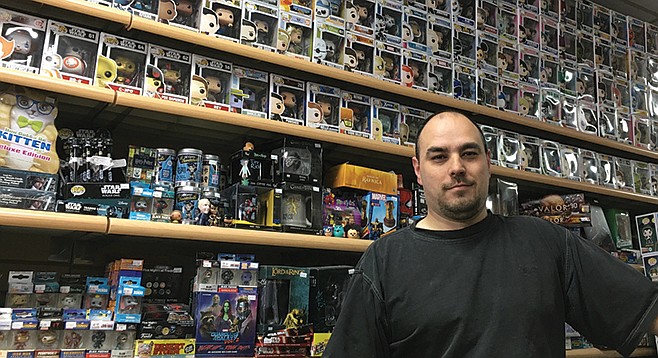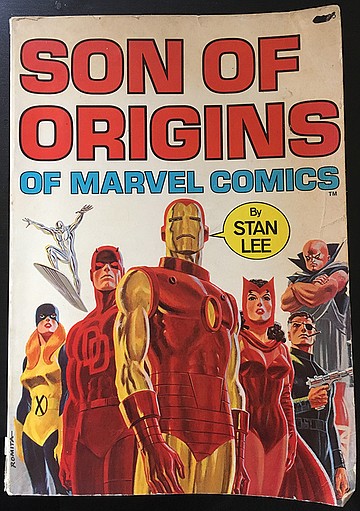 Facebook
Facebook
 X
X
 Instagram
Instagram
 TikTok
TikTok
 Youtube
Youtube

“The man is dead,” texted my brother on November 12. “Which man?” I answered. “The Man.” The capital “M” got my attention. “God?” “Yes. Blasphemy, but not by much. He was the Creator. Stan Lee.”

“He created the Marvel comic universe that I’ve been immersed in all my life” said Kenny Boeche at San Diego Comics. “Or at least, he was one of the creators. It doesn’t matter so much what percentage of this or that character he created. He was part of it. He turned the superhero genre on its ear. With DC, it was the superhero that was the identity, and the human side was the costume. Superman was an alien. Wonder Woman was basically a goddess. Aquaman was an Atlantean.” (And Batman was a reclusive and haunted billionaire.) Thanks to Lee, “with Marvel, it was who was inside the costume first.”
“That’s how he brought superheroes back to popularity,” said owner Bobby Bellman. “With characters you could relate to. You have problems at school? So does Peter Parker,” the spectacular Spider-Man. “When Lee and Marvel had a split, the backlash hit Marvel. They went back and reattached him; that’s part of why he appeared in all the movies. DC had always been more of a corporate world, but you couldn’t separate Marvel from Stan Lee. All the kids still know who he is.”

“He was the first person who worked in comics that I was aware of who wasn’t embarrassed about working in comics,” said Comic Kaze manager Lucky Bronson. “I know that in the 70s and 80s, he did a lot of college tours promoting comics. That’s why his voice is always associated with them. With Apple, we know that they wouldn’t have been what they are without Steve Jobs, without his being that type of Barnum and Bailey showman.” For comic books, “that was definitely Stan Lee.” Further, “he grounded his stories in our reality. Marvel was set in New York, instead of made-up cities like DC’s Metropolis or Gotham. It was the first time you felt that superheroes could be outside your window.”
Mike Cholak at Yesteryear Comics adds a still more personal note to Lee’s legacy. “I was having trouble reading, and my family wasn’t going to have it. So they took me to a comic book store and said to get half a dozen comic books. Nothing happened in 1983 except for Return of the Jedi, and so I picked out the first six issues of Star Wars,” a Marvel title. “They said, ‘Maybe you should pick something else,’ because it came out to $42, and that was a lot of money. But I got them, and I read them and re-read them. I got more books. In third grade, I was two years behind in reading, and by the time I got to fourth grade, I was two years ahead. Because of the way the pictures related to the words, I was starting to understand everything. It was kind of a bridge between picture books and Catcher in the Rye.”


“The man is dead,” texted my brother on November 12. “Which man?” I answered. “The Man.” The capital “M” got my attention. “God?” “Yes. Blasphemy, but not by much. He was the Creator. Stan Lee.”

“He created the Marvel comic universe that I’ve been immersed in all my life” said Kenny Boeche at San Diego Comics. “Or at least, he was one of the creators. It doesn’t matter so much what percentage of this or that character he created. He was part of it. He turned the superhero genre on its ear. With DC, it was the superhero that was the identity, and the human side was the costume. Superman was an alien. Wonder Woman was basically a goddess. Aquaman was an Atlantean.” (And Batman was a reclusive and haunted billionaire.) Thanks to Lee, “with Marvel, it was who was inside the costume first.”
“That’s how he brought superheroes back to popularity,” said owner Bobby Bellman. “With characters you could relate to. You have problems at school? So does Peter Parker,” the spectacular Spider-Man. “When Lee and Marvel had a split, the backlash hit Marvel. They went back and reattached him; that’s part of why he appeared in all the movies. DC had always been more of a corporate world, but you couldn’t separate Marvel from Stan Lee. All the kids still know who he is.”

“He was the first person who worked in comics that I was aware of who wasn’t embarrassed about working in comics,” said Comic Kaze manager Lucky Bronson. “I know that in the 70s and 80s, he did a lot of college tours promoting comics. That’s why his voice is always associated with them. With Apple, we know that they wouldn’t have been what they are without Steve Jobs, without his being that type of Barnum and Bailey showman.” For comic books, “that was definitely Stan Lee.” Further, “he grounded his stories in our reality. Marvel was set in New York, instead of made-up cities like DC’s Metropolis or Gotham. It was the first time you felt that superheroes could be outside your window.”
Mike Cholak at Yesteryear Comics adds a still more personal note to Lee’s legacy. “I was having trouble reading, and my family wasn’t going to have it. So they took me to a comic book store and said to get half a dozen comic books. Nothing happened in 1983 except for Return of the Jedi, and so I picked out the first six issues of Star Wars,” a Marvel title. “They said, ‘Maybe you should pick something else,’ because it came out to $42, and that was a lot of money. But I got them, and I read them and re-read them. I got more books. In third grade, I was two years behind in reading, and by the time I got to fourth grade, I was two years ahead. Because of the way the pictures related to the words, I was starting to understand everything. It was kind of a bridge between picture books and Catcher in the Rye.”
Comments